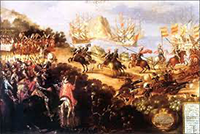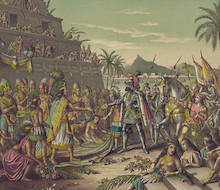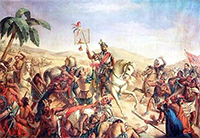Spain in the New World
Part 2: Taking Control
Another island newly populated by Spanish explorers and settlers was Jamaica, which Columbus had visited in 1494. The first Spanish settlement on that island came in 1509. Coming from Jamaica to reinforce the pacification of Cuba in later 1511 was Páfilo de Narváez, along with a contingent of soldiers. Two years later, Narváez and Velázquez led expeditions westward. Within a year, they had taken control of most of the islands and, more significantly, found gold. Dotting the island eventually were a network of Spanish settlements, including Bayamo, Havana, Puerto Principe, Sancti Spiritus, and Trinidad. Velázquez established his headquarters in what he named the capital, Santiago de Cuba. The Spanish established a network of trade between their Caribbean holdings, sending various goods between settlements and back to Spain. The leaders of these settlements were on the lookout for further opportunities and regularly sent out small voyages of exploration. At Velázquez's direction, Francisco Hernández de Córdoba was the first European known to visit the Aztec civilization, in what is now Mexico. He and a force of 100 Spaniards arrived, from Cuba, in 1517. After a brief tour of the area, he asked Velázquez to send a larger force. After another expedition the following year, led by Juan de Grijalva, Spain agreed on a larger mission; this time, the leader was Cortés. He and a few hundred men arrived in 1519 at the head of a force of a few hundred soldiers. Their mission was to establish contact and, if possible, trade with people living in Mesoamerica. 
Cortés landed on what is now the southeastern coast of Mexico. He and his men founded a settlement that would become the city of Veracruz. Cortés, at one point getting wind of the desire of many of his men to return to Cuba, ordered the ships scuttled, stranding the Spanish force on land. After a period of intense training, Cortés and 400 soldiers marched into Aztec territory and found a willing ally in Tlaxcala, a neighboring city-state then at war with the Aztecs. Along the way, Cortés made friends with other city-states wishing to throw off the Aztec yoke, including Cempoala and Huejotzingo. Helping facilitate all of this alliance-making was an enslaved woman who could speak multiple languages. She was known to her people as La Malinche; the Spaniards called her Doña Marina. 
Cortés and his invaders arrived in Tenochtitlan, the Aztec capital, in November 1519. Moctezuma, the Aztec supreme ruler, welcomed Cortés as a friend, not the least because the light-skinned Spaniard bore more than a passing resemblance to the god Quetzalcoatl, whom legend said would return. The two leaders met officially on November 8. In a series of meetings, Cortés and his men caught glimpses of a treasure room filled with gold. This put many of them in mind of conquest. The following year, Cortés was busy fighting off an insurgency within his own ranks. The Cuban governor, Velázquez, had restricted Cortés's mission to exploration and trade because the governor himself wanted to be the conquistador who took over the mainland. In April 1520, Velázquez send a large number of Spanish troops under the command of Páfilo de Narváez to wrest command from Cortés and |
|
Social Studies for Kids
copyright 2002–2025
David White



 Columbus's oldest son, Diego, became governor of Hispaniola in 1509. One of his orders from the homeland was to expand Spanish influence beyond Hispaniola, starting with Cuba. Columbus chose to lead that expedition Diego Veláazquez de Cuéllar, who had sailed with Columbus on his second voyage and who had stayed behind, founding a handful of settlements in the next few years. Veláazquez led a troop of 300 soldiers (including future explorers
Columbus's oldest son, Diego, became governor of Hispaniola in 1509. One of his orders from the homeland was to expand Spanish influence beyond Hispaniola, starting with Cuba. Columbus chose to lead that expedition Diego Veláazquez de Cuéllar, who had sailed with Columbus on his second voyage and who had stayed behind, founding a handful of settlements in the next few years. Veláazquez led a troop of 300 soldiers (including future explorers  to kill him if necessary. Cortés left a contingent of soldiers in Tenochctitlan under the command of one of his lieutenants, Pedro de Alvardo (left). Cortés surprised Narváez's forces and destroyed them, then returned to Tenochtitlan, picking up more allies on the way. He first had to deal with the fallout from Alvarado's ordering an attack on Aztecs during a religious festival at the Temple Mayor. Cortés got his men out of the city, seeking refuge in Tlaxcala. It was during this time that smallpox hid Tenochtitlan hard, killing even the supreme ruler, Cuitlahuac. The former military ruler gave way to Moctezuma's nephew, and the stage was set for the final encounter.
to kill him if necessary. Cortés left a contingent of soldiers in Tenochctitlan under the command of one of his lieutenants, Pedro de Alvardo (left). Cortés surprised Narváez's forces and destroyed them, then returned to Tenochtitlan, picking up more allies on the way. He first had to deal with the fallout from Alvarado's ordering an attack on Aztecs during a religious festival at the Temple Mayor. Cortés got his men out of the city, seeking refuge in Tlaxcala. It was during this time that smallpox hid Tenochtitlan hard, killing even the supreme ruler, Cuitlahuac. The former military ruler gave way to Moctezuma's nephew, and the stage was set for the final encounter.
